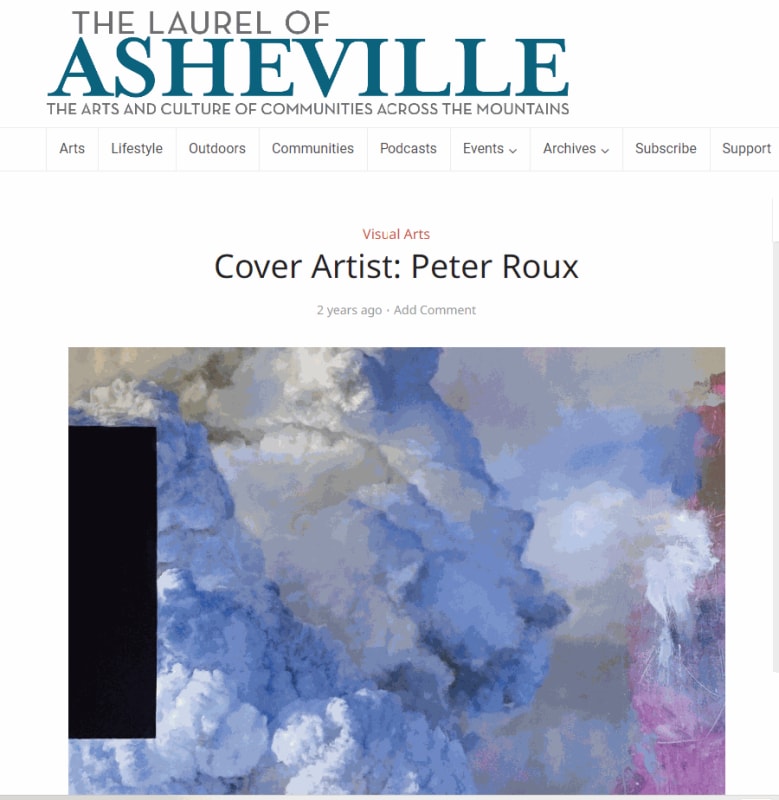Like many artists, Peter Roux shared his knowledge and talent with others in order to support his own art practice early in his career, teaching drawing and painting as an adjunct faculty member at Lesley University College of Art and Design in Massachusetts. “After a few years, my studio practice became successful enough that I dropped the adjunct teaching, although I still teach workshops and selective one-on-one sessions through my studio,” he says. “I love to teach and will continue to do so while balancing it with the time needed to create my own work.”
Peter works in a studio at Riverview Station, with a gallery, Sky + Ground Contemporary Art, adjacent to his workspace. “Opening Sky + Ground Contemporary was a great way to showcase art for the public,” he says. “Folks can visit the gallery and also pop into my studio to see new work and works in progress.” His wife Rachel helps manage the gallery.
Primarily a landscape painter, Peter also works in abstraction and enjoys pushing the two together, he says. “I see landscape and nature in my abstract work, and abstraction in my landscape, so the relationship is obvious and strong. In fact, for me, there’s little distinction beyond the immediate form.”
Growing up in a military family that moved around quite a bit, Peter says that he found himself drawn to making art and was supported by his family and educators in his pursuits. “As a child, I was constantly drawing and sketching, spending much of my time in the inner worlds I would create on paper. I was a good student, but my real confidence was built through art. It calmed me when I made it and just felt like a natural extension of my thoughts.”
A visual person by nature, he says that images “made a certain sense to me and made me feel things. I think I’m just wired that way. I’d draw anything that held my interest—stories, people, animals, places. The visual world was poetry to me.”
At a small high school in Massachusetts where his family eventually settled, he was encouraged to draw and paint. “It was just a foregone conclusion that art school was my path,” he says. “I don’t remember ever considering anything else.” He continued his studies at Massachusetts College of Art and Design, and, after graduation began his career as an artist in Boston.
Having his work published in New American Paintings, a national juried catalog, drew the attention of galleries and art dealers. “This formed the foundation for my career, and I slowly built on it,” Peter says. “I began having gallery shows, selling and getting commissions.”
He works primarily in oil and draws, mostly in charcoal. “I was drawing long before I ever started painting,” he says, “and I think my painting is informed by this. I consider myself more of a tonal painter than a colorist. I love color, but I see everything through values as a starting point, likely driven by my drawing.”
Scarcity of subject matter is not a problem Peter faces. “I think of more ideas than I ever have time to create,” he says. “One idea generates another. A view out a window might spark a thought that creates a piece. I’ll jot down notes for future work, just to make sure I don’t forget.”
In recent years, he has created a large body of commissioned work for hotels, healthcare facilities and corporate collections. “Many of these projects allow me to work in a larger scale,” he says, “which I love.”
He continues today with a large series of cloud paintings that he began a few years ago. “For me, clouds are a great starting point, a way in,” he says. “With few exceptions in the world, clouds are a universal subject no matter where one lives, no matter what the nature of the landscape around one might be; looking up one finds a familiar connection.” The ability of clouds to hold light and their constant movement are great challenges for a painter, he adds. “To use these as a vehicle to explore how we see is almost too seductive to ignore. Although they are not by any means my only subject of interest, they’re pretty center stage right now.”
Besides a range of subjects, Peter also works in various sizes from 4” square to ones more than ten feet in length. The paintings, once begun, often tell him where they want to go, he says, and he feels a strong connection to the work while creating it and a sense of being grounded in the creative process.
“If I had a chance to do it all over again, being an artist would still be my career path of choice,” Peter says. “I think at this point I’m not really suited to do anything else.”

